Macropoma is an extinct genus of coelacanth in the class Sarcopterygii. Fossils of Macropoma have been found in both England and Czech Republic, dating to the mid-Cretaceous (Albian-Turonian). Recorded fossils have bodies under two feet in length. A modern coelacanth measures five or more, but in other respects the two genera are remarkably similar, and share the same body plan with a three-lobed tail and stalked fins.

Chinlea is an extinct genus of late Triassic Mawsoniid coelacanth fish found in and named after the Chinle Formation that crops out in the southwestern states of Arizona and New Mexico. The word “Chinle” comes from the Navajo word meaning "flowing out", referencing the location where water flows out of the Canyon de Chelly. They were also possibly found in the Dockum Group.

Latimeriidae is the only extant family of coelacanths, an ancient lineage of lobe-finned fish. It contains two extant species in the genus Latimeria, found in deep waters off the coasts of southern Africa and east-central Indonesia. In addition, several fossil genera are known from the Mesozoic of Europe, the Middle East, and the southeastern United States, dating back to the Triassic.

Chaoyangopterus is a genus of chaoyangopterid pterosaur known from a partial skeleton found in Liaoning, China. Chaoyangopterus was found in rocks dating back to the Aptian-age Lower Cretaceous Jiufotang Formation of Dapingfang, Chaoyang.

Chroniosuchidae is a family of semi-aquatic tetrapods found in sediments from the upper Permian and the upper Triassic periods, most in Russia. They were generally rather large animals, with long jaws similar to those found in modern crocodiles, and probably lived a similar lifestyle as riverside piscivores and ambush predators. Like all chroniosuchians, they bore extensive osteoderm armour on their backs, possibly as protection against terrestrial predators such as the Permian therapsids and the Triassic rauisuchians.

Mawsonia is an extinct genus of prehistoric coelacanth fish. It is amongst the largest of all coelacanths, with one quadrate specimen possibly belonging to an individual measuring 5.3 metres in length. It lived in freshwater and brackish environments from the late Jurassic to the mid-Cretaceous of South America, eastern North America, and Africa. Mawsonia was first described by British paleontologist Arthur Smith Woodward in 1907.

Holophagus is an extinct genus of coelacanth belonging to Latimeriidae. The type species, Holophagus gulo, is known from the Lower Jurassic marine Lias of England. Some authors have considered the genus restricted to the Lias of England.
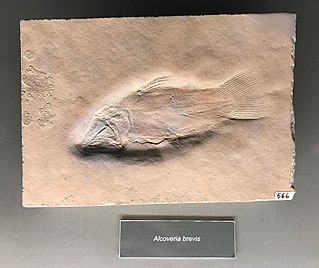
Alcoveria is an extinct genus of mawsoniid coelacanth fish which lived during the Triassic period. Alcoveria is known from a well preserved specimen from Spain. It lived in a marine environment.

Mawsoniidae is an extinct family of prehistoric coelacanth fishes which lived during the Triassic to Cretaceous periods. Members of the family are distinguished from their sister group, the Latimeriidae by the presence of ossified ribs, a coarse rugose texture on the dermatocranium and cheek bones, the absence of the suboperculum and the spiracular, and reduction or loss of the descending process of the supratemporal. Mawsoniids are known from North America, Europe, South America, Africa, Madagascar and Asia. Unlike Latimeriidae, which are exclusively marine, Mawsoniidae were also native to freshwater and brackish environments. Mawsoniids represent among the youngest known coelacanths, with the youngest known remains of the freshwater genus Axelrodichthys from France and an indeterminate marine species from Morocco being from the final stage of the Cretaceous, the Maastrichtian, roughly equivalent in age to the youngest known fossils of latimeriids. Species of Mawsonia and Trachymetopon are known to have exceeded 5 metres in length, making them among the largest known bony fish to have ever existed.

Whiteia is an extinct genus of prehistoric coelacanth fish which lived during the Triassic period. It is named after Errol White.

Pteronisculus is an extinct genus of prehistoric ray-finned fish that lived during the Early Triassic and Middle Triassic epochs of the Triassic period worldwide.
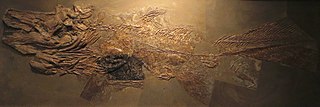
Trachymetopon is an extinct genus of prehistoric coelacanth from the Jurassic of Europe. Fossils have been found in the Early Jurassic Posidonia Shale of Germany the Middle Jurassic Marnes de Dives of France, and probably the Late Jurassic Kimmeridge Clay of England. Only one species has been named, Trachymetopon liassicum, described by Henning in 1951 from an almost complete specimen found in the Lower Toarcian of Ohmden in Baden-Württemberg. Another specimen is known from the same site, and two older specimens come from the Sinemurian of Holzmaden. The holotype of this species is 1.6 metres in length. A giant specimen of an undetermined species of Trachymetopon found at the Middle Jurassic Falaises des Vaches Noires of Normandy. This specimen, composed of a 53 cm long palatoquadrate, belongs to an individual 4 metres (13 ft) in length. A basisphenoid found in a museum in Switzerland that likely originates from the same locaity probably belonged to an individual around 5 m (16 ft) long, making Trachymetopon the largest of all coelacanths alongside Mawsonia. A study published in 2015 revealed that this coelacanth belongs to the Mawsoniidae. Trachymetopon is one of the few known mawsoniids to have been exclusively marine, while most of the other members of the group have lived in fresh and brackish waters.
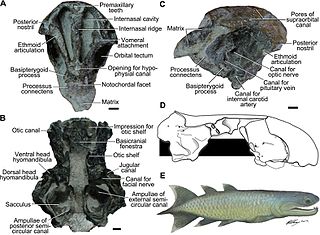
Qingmenodus is a genus of prehistoric lobe-finned fish. Fossils of Qingmenodus were found in China and date back to the Early Devonian period. Qingmenodus reveals the first well-ossified otoccipital braincase in onychodonts. Palaeontologists believe that Qingmenodus was one of the oldest onychodont fish.
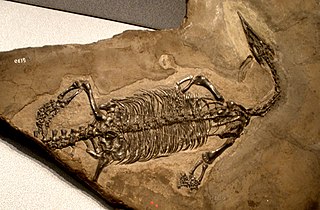
Askeptosauroidea is a superfamily of thalattosaurs, a Triassic group of marine reptiles. Askeptosauroidea is one of two major subgroups of Thalattosauria, the other being Thalattosauroidea. It includes the family Askeptosauridae and a more basal form called Endennasaurus.

Thalattosauroidea is a superfamily of thalattosaurs, a Triassic group of marine reptiles. It was named in 1904 by paleontologist John Campbell Merriam to include the genus Thalattosaurus from California. Thalattosauroids are one of two groups of Thalattosauria, the other being Askeptosauroidea. Thalattosauroids make up the "traditional" thalattosaurs with large downturned snouts, short necks, and long, paddle-like tails.

Sinophoneus is an extinct genus of carnivorous dinocephalian therapsid belonging to the family Anteosauridae. It lived 272 to 270 million years ago at the beginning of the Middle Permian in what is now the Gansu Province in northern China. It is known by a skull of an adult individual, as well as by many skulls of juvenile specimens. The latter were first considered as belonging to a different animal, named Stenocybus, before being reinterpreted as immature Sinophoneus. Sinophoneus shows a combination of characters present in other anteosaurs. Its bulbous profile snout and external nostrils located in front of the canine are reminiscent of the basal anteosaur Archaeosyodon, while its massive transverse pterygoids processes with enlarged distal ends are more similar to the more derived anteosaurs Anteosaurus and Titanophoneus. First phylogenetic analyzes identified Sinophoneus as the most basal Anteosaurinae. A more recent analysis positioned it outside the Anteosaurinae and Syodontinae subclades, and recovers it as the most basal Anteosauridae.
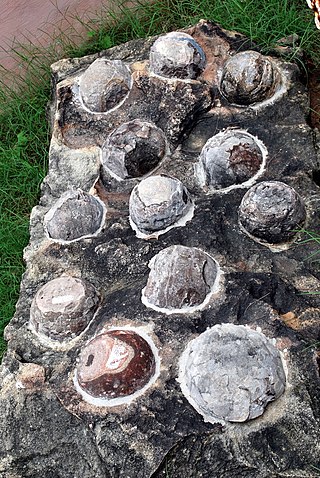
Egg fossils are the fossilized remains of eggs laid by ancient animals. As evidence of the physiological processes of an animal, egg fossils are considered a type of trace fossil. Under rare circumstances a fossil egg may preserve the remains of the once-developing embryo inside, in which case it also contains body fossils. A wide variety of different animal groups laid eggs that are now preserved in the fossil record beginning in the Paleozoic. Examples include invertebrates like ammonoids as well as vertebrates like fishes, possible amphibians, and reptiles. The latter group includes the many dinosaur eggs that have been recovered from Mesozoic strata. Since the organism responsible for laying any given egg fossil is frequently unknown, scientists classify eggs using a parallel system of taxonomy separate from but modeled after the Linnaean system. This "parataxonomy" is called veterovata.
The Ermaying Formation is a geological formation of Anisian age in north-central China. It is found across much of the Ordos Basin, at outcrops within the provinces of Shaanxi, Shanxi, and Inner Mongolia. It is composed of up to 600 m thick sequence of mudstone and sandstone, overlying the Heshanggou Formation and underlying the Tongchuan Formation. In the southern part of the Ordos Basin, the Zhifang Formation is equivalent to the Ermaying Formation.

Tapejaroidea is a group of pterosaurs belonging to the clade Ornithocheiroidea. Tapejaroids lived from the Early to Late Cretaceous periods, with one possible member, Tendaguripterus, extending the fossil range to the Late Jurassic period. Tapejaroidea contains two groups, the Dsungaripteridae and the Azhdarchoidea, which in turn includes the azhdarchids, the group that contains some of the largest flying animals. The group was named by Brazilian paleontologist Alexander Wilhelm Armin Kellner in 1996.

Foreyia is an extinct genus of coelacanth lobe-finned fish which lived during the Middle Triassic period in what is now Canton of Graubünden, Switzerland. It contains a single species F. maxkuhni.





















